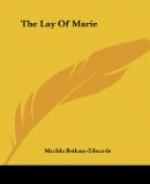* * * * *
No. XI.—Translation of the Lai DEE CHEVREFOIL:
(From Notes to Sir Tristrem, edited by Walter Scott, Esq.)
I am much pleased with the lay which is called Chevrefoil. Let me relate to you truly on what occasion it was made, and by whom. Many persons have narrated the story to me; and I have also found it in writing, in the work which treats of Tristrem, and of the Queen; and of their constant love, from which they suffered a thousand sorrows; and expired on the same day.[81]
King Markes had been much offended with his nephew, Tristrem; and had banished him on account of his attachment to the queen. The knight retired into the country where he was born; spent there a whole year of affliction; and, being still forbidden to return, became careless of life. Do not wonder at this; for a true lover, where his wishes are crossed by insuperable obstacles, can set no bounds to his grief. Tristrem, therefore, thus driven to despair, left his home; passed into Cornwall, the abode of the queen, and concealed himself in the thickest part of the forest; from which he issued only at the close of the day, at which time he took up his lodgings among the peasants and the poorest of mankind. After frequent questions to these his hosts, concerning the public news of the court, he at length learned the king had convoked his barons, and summoned them to attend him at Pentecost, at the castle of Tintagel. Tristrem was rejoiced at this news; because it was impossible the queen could arrive at the meeting without giving him an opportunity of getting sight of her during the journey. On the appointed day, therefore, be took his station, in that part of the wood through which the road passed, cut down a branch of codre (hazel), smoothed it, wrote his name on it with the point of his knife, together with other characters, which the queen would well know how to decypher. He perceives her approaching; he sees her examine with attention every object on her road. In former times they had recognized each other by means of a similar device; and he trusts, that, should she cast her eyes on the stick, she will suspect it to belong to her lover. This was the purport of the characters traced on it: “That he had long been waiting at a distance, in hopes of being favoured with some expedient which might procure him a meeting, without which he could no longer exist. It was with these two, as with the chevrefoil and the codre. When the honey-suckle has caught hold of the codre, and encircled it by its embraces, the two will live together and flourish; but if any one resolves to sever them, the codre suddenly dies, and the honey-suckle with it. Sweet friend, so it is with us; I cannot live without you, nor you without me.”




